 Indians Archive
Indians Archive  Cleveland Sports Vault: Tribe “Deep Tracks” Trivia, Vol. 1
Cleveland Sports Vault: Tribe “Deep Tracks” Trivia, Vol. 1
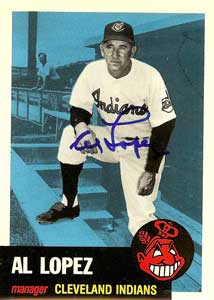 You’ve been studying the franchise your whole life. You structure your schedule around their daily rhythms, nine months out of every year.
You’ve been studying the franchise your whole life. You structure your schedule around their daily rhythms, nine months out of every year.
Typical Cleveland Indians trivia questions? They add little to the catalog of knowledge you have cultivated. The top highlights of the team’s past are fine for the national media to discover every couple years (as in: ...the Indians won 111 games in 1954 and were swept in four games and Willie Mays made a nice catch…). But you have long moved past such ‘low hanging fruit.’
The history of the Indians franchise is rich with stories that are full of texture. Some are humorous, others are poignant, and still others hold intrigue as a sign of their times. The best trivia is rooted in such stories.
Expressed in terms of a radio format, consider your local FM Classic Rock station. You'll hear some nice tunes there- you’d play expert air guitar to Jimi Hendrix, and air drums to Grand Funk Railroad. Same here- and I am familiar enough with those as to not require a “white man’s overbite.” That's the point, though. We've heard those hits over and over- you may have become half-tired of them when they were first released. That’s why many favor a “deep tracks” approach. Those seldom-heard gems - from top-selling and unheralded albums alike – expand their experience and challenge their insight.
With this in mind, take a shot at some “deep tracks” trivia questions. Feel free to share your own thoughts, or to disagree with mine.
1) An Indians manager is generally credited with being the first to tap his arm that corresponded to the throwing arm of the reliever he wanted to enter the game. Before he began this practice, he was known to employ creative signs to communicate to the bullpen. He performed these while walking to the mound.
Mike “The Bear” Garcia rarely pitched out of the pen, but this manager signaled for him by holding his arms out- as if he were fat. Garcia wasn’t exactly fat, but the sign was effective.
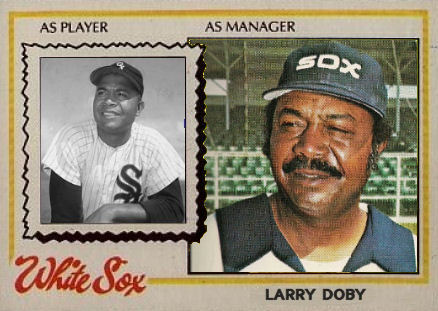 The manager signaled for Ray Narleski by drawing an imaginary “N” in the air.
The manager signaled for Ray Narleski by drawing an imaginary “N” in the air.
He signaled for Don Mossi by cupping his hands over his ears, mimicking the big-eared Mossi.
Who was this manager?
2) When Frank Robinson came to the Cleveland Indians in 1974, Larry Doby was a coach on the team. Back in 1947, Doby had been the first black ballplayer in the American League. Tribe owner Bill Veeck hired him as the second black player in the big leagues, after Jackie Robinson.
Doby (the card is not real- it is photoshopped) did not become the first black manager; Frank Robinson did. His first season as Tribe skipper was in 1975. Doby did become the second black big league manager, when the Chicago White Sox hired him. Who was the White Sox owner?
3) More Doby. In the 1950s, the Indians were very good (even better than they had been in the late 1930s). There was no playoff system, and the Yankees were usually better- but not in 1954, when the Tribe won the pennant.
Yogi Berra won the American League MVP Award in 1954. But Doby had very similar stats that season.
Besides Doby, who on the Indians garnered first place votes in the A.L. MVP award race?
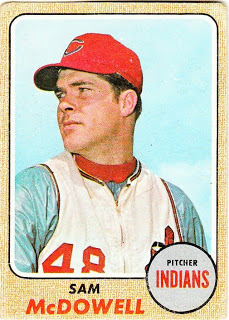 (Hint- there were three, and the 1953 winner- an Indian- was not among them.
(Hint- there were three, and the 1953 winner- an Indian- was not among them.
Another hint- one was a pitcher.)
4) In September of 1969, gifted left handed starter Sam McDowell was having a bad game in Baltimore. He complained to umpire Larry Barnett throughout. By the sixth inning, Sudden Sam said the words that automatically get a player thrown out of a game.
He would be fined by the league for throwing the ball into the stands behind third base. How much did McDowell pay for his fine, and why?
a) $205. A.L. president Joe Cronin called Barnett. He asked where the ball landed. Barnett said row 205, so Cronin fined Sam $1 per row.
b) $216. McDowell was fined $205 all right, but insisted his throw cleared all 216 rows.
c) $216. The fine was for $205, but McDowell was from Pittsburgh, and exchange rates with foreign locales can fluctuate.
d) $216. McDowell was just representin’ the C-town area code in the future home of the Cleveland Browns.
5) Superscout Cy Slapnicka famously signed Bob Feller out of Van Meter, Iowa. In fact, he was responsible for signing many of the Indians players of the 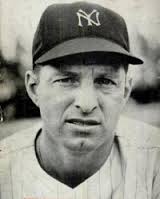 post-WWII glory years.
post-WWII glory years.
He- and other scouts- cut corners and skirted the rules in signing young ball players. Feller’s signing in 1937 was at odds with the rule that a team could not sign sandlot ballplayers directly to a big league club. He had been signed to a minor league team by the Indians, but never reported there. Baseball commissioner Judge Kennesaw Mountain Landis decided Feller was to become a free agent, allowing any team to sign him. Feller insisted he wanted to remain with the Indians, who happily paid a fine.
Another player was signed by Slapnicka in 1937. He was stashed in the minors, effectively being shielded, or “covered up” and not accessible to teams who could use him on their major league roster. He jumped at the chance to become a free agent, signing with the New York Yankees. He is now in the Hall of Fame. Who is he?
6) In 1920, native Clevelander Bill Wambsganss performed an unassisted triple play in the World Series, at Dunn Field (League Park). He said he was ready for it, partly because his teammates had talked about another player whom had pulled one off during the regular season in 1909, with the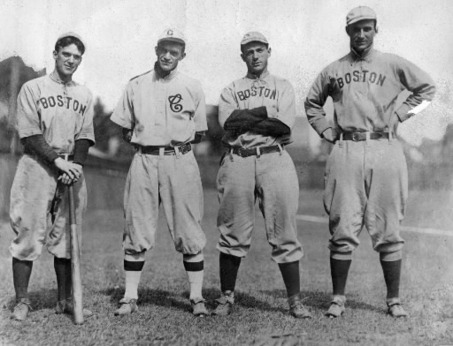 Cleveland Naps. It was the first unassisted triple play in major league history, and his glove is displayed at the Hall of Fame in Cooperstown.
Cleveland Naps. It was the first unassisted triple play in major league history, and his glove is displayed at the Hall of Fame in Cooperstown.
Cy Young was on the mound at the time, and was confused by the play- he asked this player why he was leaving the field. Once the fans realized what had happened, they rose for a standing ovation.
Who was the shortstop who performed this feat (shown at right, with his three victims)?
7) Of the following ball players, whom does not belong? Why?
Also, name the player who is missing.
Herb Score
Chris Chambliss
Kenny Lofton
Sandy Alomar, Jr.
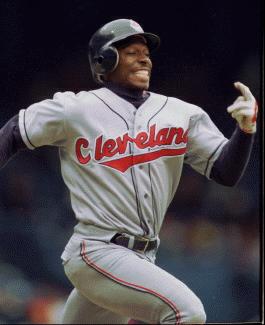 8) Kenny Lofton was traded by the Cleveland Indians in March of 1997. Tribe GM John Hart was afraid that he was not going to be able to re-sign Lofton, and feared he would walk a la Albert Belle. Lofton returned in 1998. We love the guy, and he is one of the core of the 1990s era. From 2001 through his final season of 2007, Lofton played on ten teams.
8) Kenny Lofton was traded by the Cleveland Indians in March of 1997. Tribe GM John Hart was afraid that he was not going to be able to re-sign Lofton, and feared he would walk a la Albert Belle. Lofton returned in 1998. We love the guy, and he is one of the core of the 1990s era. From 2001 through his final season of 2007, Lofton played on ten teams.
Name them, in order.
2001 Indians
2002 _______________
2002 _______________
2003 _______________
2003 _______________
2004 _______________
2005 _______________
2006 _______________
2007 _______________
2007 Indians
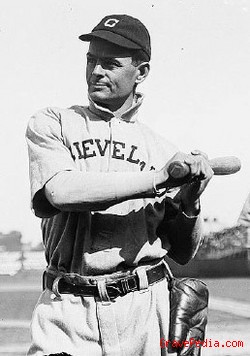
9) By 1907, Bedford, Ohio native Elmer Flick was a star player for the Cleveland Naps. He’d had a great career, one that would eventually get him elected to the Hall of Fame.
But the Naps almost dealt him. A deal was in place, and the Naps backed away.
Who was the deal to be consummated with, and who were the Naps to get in return?
(In retrospect, the Naps should have made the deal. In fairness, they could not have foreseen the physical ailments that would plague Flick in the future; he only lasted a couple more seasons in the big leagues.)
10) Vernon Stouffer owned the Indians from 1966 to 1972. Hank Greenberg was a Tribe GM and part owner in the 1940s and 50s. In their role as owner, what do these men have in common? Think in terms of an Indians fan.
--------------------------------------------------------------------------------------------------------
Here are the answers:
1) The manager was Al Lopez.
2) The White Sox owner was Bill Veeck.
3) Getting first place votes in the 1954 A.L. MVP race were Doby, Bobby Avila and Bob Lemon. They were all top-five vote-getters.
6th was Early Wynn; tied for 15th was 1953 winner Al Rosen; tied for 19th was Mike Garcia and 22nd was Jim Hegan.
4) The answer is b).
5) The Hall of Famer is Tommy Henrich.
6) The shortstop who performed the first major league triple play was Neal Ball.
7) The play who does not belong is Lofton. The others each won a Rookie of the Year award while with the Indians. Lofton finished second, to Milwaukee’s Pat Listach. ( I didn’t mind the competitive Lofton having this fire lit under him.)
The missing player is Joe Charboneau.
8) Hoo boy. Indians/White Sox/Giants/Pirates/Cubs/Yankees/Phillies/Dodgers/Rangers/Indians.
9) The Detroit Tigers wanted to move Ty Cobb to the Naps, for Elmer Flick. Cleveland backed away at the last minute. Cobb was already a top star in the league, but the Tigers were weary of his volatile, confrontational personality.
10) Each of these men tried to move the Cleveland Indians to another city.
Greenberg was behind a potential move to Minneapolis in 1957. The other owners backed out at the last minute.
Stouffer had bought into the Indians in 1964, when it appeared they might be moved to Seattle. By 1970, after several years of mismanagement and money losses, Stouffer was being wooed by markets such as Dallas and New Orleans. He made a deal to have the Indians play 30 home games per season in New Orleans, but the league vetoed that.
Neither of these men Modelled the Indians out of Cleveland, but it wasn't for a lack of trying. I guess their 'mistake' was in allowing their intentions to be made public. Arty the Smarty was way too savvy for that.
(People lament Stouffer’s rejection of George Steinbrenner’s offer to buy the Indians, thinking that would have injected life into the franchise. We should be glad he wasn’t allowed to sell out to the interests of another market.)
Stouffer:
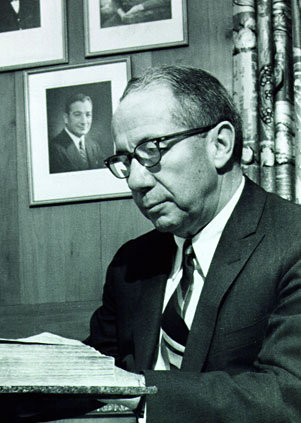
- NBA Announces 2013-2014 Schedule
- Browns Ink Sharknado
- Sharknado A No-Show For Rookie Camp
- Trent Richardson Out Until Training Camp
- Browns Sign Brandon Jackson
- Carrasco Suspended Eight Games
- Browns Add to Wide Receiver Depth with David Nelson
- Browns Need to Learn from Past Draft Mistakes
- Browns Release Chris Gocong and Usama Young
- Browns Missing on Grimes Disappointing, But Not The End
The TCF Forums
- Chris Grant's first 3 drafts
Kingpin74 (Tuesday, January 21 2014 10:13 AM) - The 2014 Offseason Thread
googleeph2 (Tuesday, January 21 2014 9:36 AM) - 2015 Recruiting
furls (Tuesday, January 21 2014 6:57 AM) - Mike Brown
YahooFanChicago (Monday, January 20 2014 11:15 PM) - Movies coming out
HoodooMan (Monday, January 20 2014 9:34 PM) - 2014 Hoops Hockey Hijinx
jpd1224 (Monday, January 20 2014 4:44 PM) - 2014 Recruiting
jclvd_23 (Monday, January 20 2014 2:26 PM) - Wish List - #4 Pick
Hikohadon (Monday, January 20 2014 1:26 PM) - Official- Browns Coach Search/Rumors
OldDawg (Sunday, January 19 2014 6:48 PM) - #1 overall pick Anthony Bennett
TouchEmAllTime (Sunday, January 19 2014 1:28 PM)



